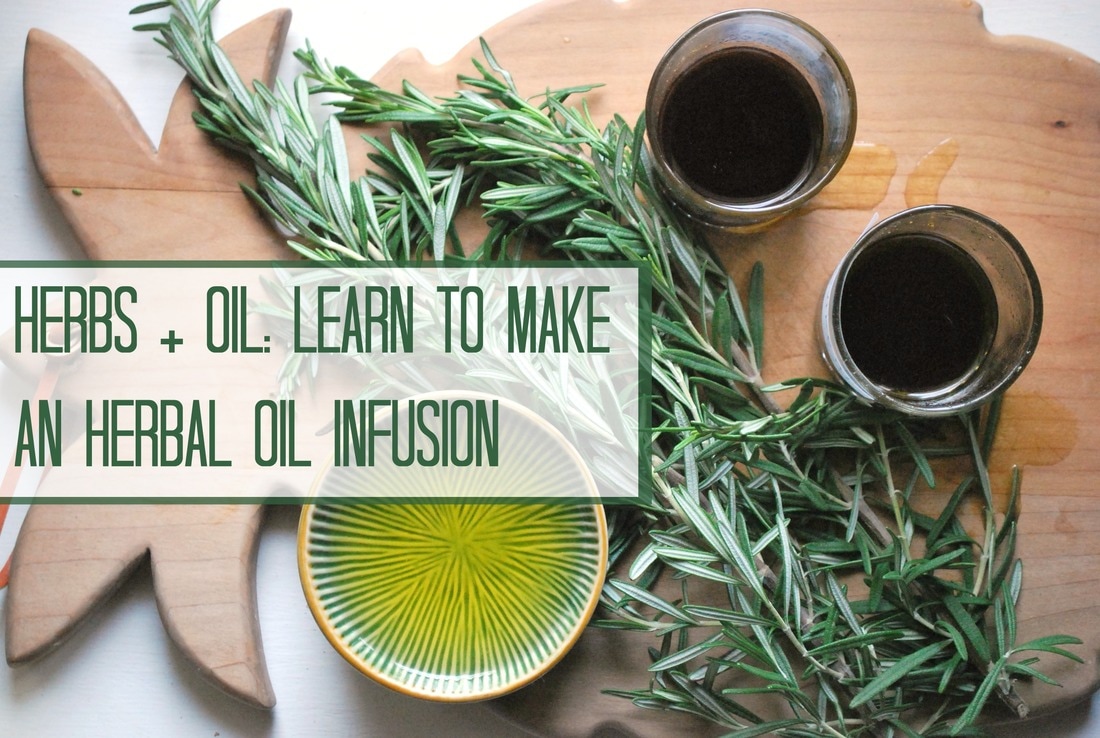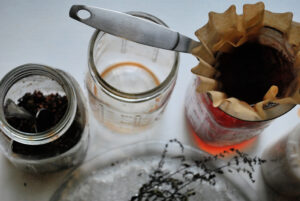Links contained in this post and elsewhere on my website may include affiliate links. When you make a purchase through these links, I earn a commission at no additional cost to you. I only link to products and services that I love - and that I think you will love, too!
Welcome to Day 13 of the 40 Day Herbalist Challenge. Herbs + Oil is a useful combination. By infusing herbs in oil you can create flavorful ingredients for your kitchen that allow you to add beneficial herbs to your favorite recipes. You can also create infused oils intended for topical use with herbs that support the skin and muscles.
Time Needed: About an hour
Tools and supplies needed:
Microwave
Double boiler or metal saucepan and glass canning jar
Water for the double boiler or pan and jar
½ cup fresh rosemary leaves
1 cup olive oil
As with infusing herbs into alcohol, using herbs + oil is a pretty basic concept. Herbs are allowed to soak in the oil of your choice to create your custom herbal oil.
The most important thing to remember when making herbal oils is that making them with fresh herbs is a really bad idea. Yes. You read that correctly: in this case, using fresh herbs is definitely bad.
Here’s why. Botulism spores love the oxygen free environment created by oil and the moisture from your fresh herbs. So rather than have your oils spoil dangerously, go ahead and use dried.
That’s why the rosemary oil recipe below calls for dried rosemary. I also explain how to dry your fresh rosemary in a microwave so that you can have very dried herbs in very little time. The cool thing about using the microwave in this case is that the microwave works by targeting water. So it leaves most of the good stuff we want in the herbs and gets rid of the water for us. (I learned about this trick here).
I usually use olive oil or sesame oil because they are readily available in my area, and chose olive oil in this recipe because of flavor. Incidentally, infused rosemary oil is actually a nice dual purpose cooking oil and muscle rub! Topically, rosemary is warming and invigorating, so I sometimes use it for over-worked muscles, and it’s nice dabbed on the temples to support concentration and clear the mind.
DIY Rosemary Oil
½ cup fresh rosemary leaves
1 cup of olive oil
Dry the Rosemary
- Strip the rosemary leaves from their stems and pack them into a measuring cup until you have ½ a cup. Spread your leaves into a thin layer on a clean dish towel in the microwave and cover with another dish towel.
- Microwave for 30 second increments and check on your herbs to determine how dry they are. Once they are close, decrease the time of each microwave session to 15 seconds until they are dry. Mine took about 4 minutes total, but it will depend on the microwave.
Infusing the Oil
- Pack your freshly dried rosemary into a glass canning jar and pour your olive oil on top.
- Place the jar into a sauce pan (non enamel, so that the glass doesn’t scratch up your enamel) and add water to the pan so that the water half fills the pot. If you have a double boiler, you can use that instead.
- Place the pan over low heat for 60 minutes, then remove from the heat and allow your oil to cool. Strain your oil through a mesh strainer, bottle in a clean jar with lid, and enjoy! You can use it to taste in your favorite dishes or use it as a warming massage oil that supports circulation.
Good Things to Know About Herbs + Oil
Making Salves
Once you have an infused oil, you can make a salve! I like using 8 oz of oil by volume to 1 oz of beeswax by weight, but you can adjust the amount of wax up or down to change the hardness or softness of the salve. If I don’t feel like weighing, I will use a one inch cube of beeswax cut from the 1lb block I keep on hand. By dripping the salve onto a cool plate I can adjust as I go.
Staying Safe
Besides not using fresh herbs to make your infused oils, it’s also a good idea to avoid using oils or salves on fresh cuts or scrapes or open sores. That whole oil + bacteria thing again, I’m afraid – although this time the main concern would be creating the perfect habitat for a staph infection or something equally as nasty. I use salves once minor injuries have begun to heal and use herbal compresses, extracts, and/or honey in the meantime.
Essential Oils
Infused oils like the one above and essential oils, which are wildly popular right now, are not at all the same thing. Essential oils are extremely concentrated aromatic preparations made by distillation. So concentrated, in fact, that they are capable of causing a burn on the skin or to sensitive mucous membranes if used incorrectly! If you want to learn how to use them (like herbs, they can be a wonderful tool when used with knowledge and mindfulness) I love this roundup of articles The Ultimate Essential Oils Guide as a place to start.
Your Mission
All the Best,
Agatha
More Fun!
|
Check out 5 Ways to Make an Herbal Infused Oil for some other great ideas for the process of making herbal oils!
You can also read my article on using a yogurt maker for herbal oils. It’s a great way to make small batches of several oils at once. |
Agatha is the author of the popular new herbal recipe book, Adaptogens: Your Guide to Radiant Health!
|




